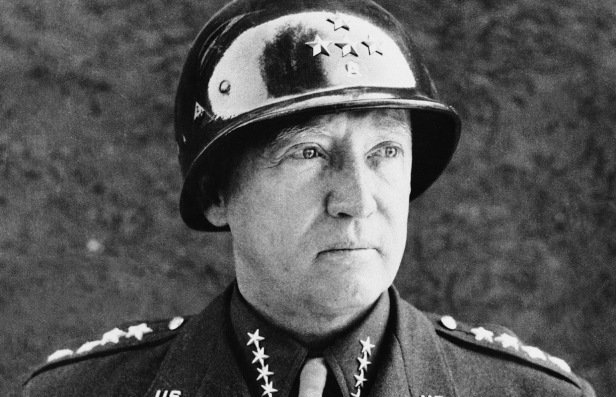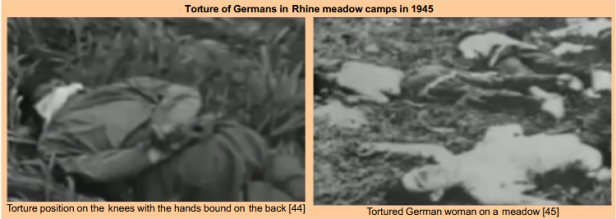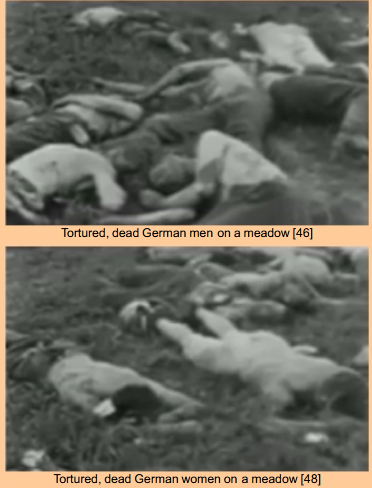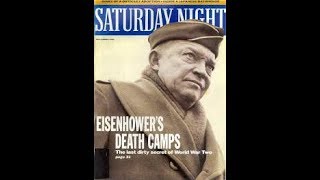By John Wear
Smith fails to address allegations that Eisenhower as head of Supreme Headquarters Allied Expeditionary Force (SHAEF) oversaw the mass murder of hundreds of thousands of German POWs after World War II. This Allied atrocity was first publicly exposed in 1989 in the book Other Losses by James Bacque
Warning: This post contains graphic images.


Book Review of Eisenhower in War and Peace
Author Jean Edward Smith deserves credit for the extensive research he did in writing this well-written book. While Eisenhower in War and Peace portrays Eisenhower as an essentially good man, Smith does not hesitate to portray some of Eisenhower’s flaws. For example, Smith thoroughly documents Eisenhower’s affair with Kay Summersby during World War II.[1] Eisenhower even wrote to General Marshall after the war saying that he wanted to be relieved of duty so that he could divorce his wife Mamie and marry Kay.[2]
However, when Eisenhower decided to return to Washington in November 1945 to succeed General Marshall as chief of staff, Eisenhower wrote a “Dear John” letter to Kay Summersby. Smith writes about this letter:
The postscript notwithstanding, Eisenhower’s letter to Kay is cold-blooded and ruthless. FDR would have been incapable of writing such a missive, and George Patton would have said a warmer good-bye to his horse. With his letter Eisenhower closed the book on his relationship with Kay Summersby. Kay would not completely go away, but Ike had taken the necessary step to restore his marriage to Mamie and resume his career. Eisenhower and his son John have been assiduous in their attempt to minimize the role Kay Summersby played in Ike’s life.[3]
Smith also discusses many of Eisenhower’s military mistakes and failures throughout his book. For example, in regard to the Allied failure to take Tunis, Smith writes: “In their postwar memoirs, Eisenhower and Clark imply that General Anderson was to blame for the failure to take Tunis because he did not strike out boldly. Yet the primary responsibility rested with Ike.”[4]
Smith also writes that Eisenhower acknowledged that he had erred by pressing II Corps too far forward in Tunisia:
Had I been willing to pass to the defensive, no attack against us could have achieved even temporary success.”[5]
Eisenhower in War and Peace also documents many of the criticisms Allied military leaders made of Eisenhower’s military performance. For example, British Field Marshal Bernard L. Montgomery confided to Field Marshal Sir Alan Brooke: “I think now that if we want the war to end within any reasonable period you will have to get Eisenhower’s hand taken off the land battle. He has never commanded anything in his whole career; now, for the first time, he has elected to take direct command of very large-scale operations and he does not know how to do it.”[6]
Meeting with the British chiefs of staff on November 24, 1944, Field Marshall Alan Brooke called for Eisenhower’s replacement:
I put before the Committee my views on the very unsatisfactory state of affairs in France, with no one running the land battle. Eisenhower, though supposed to be doing so, is on the golf links at Reims—entirely detached and taking practically no part in running of the war. Matters got so bad lately that a deputation of [Major General J.F.M. “Jock”] Whiteley [SHAEF’s deputy chief of staff], Bedell Smith and a few others went up to tell him that he must get down to it and RUN the war, which he said he would. Personally, I think he is incapable of running the war even if he tries.[7]
Smith interestingly documents in his book that many top American military officers had strong anti-Jewish sentiments. Probably the most outspoken of these officers was American General George Van Horn Moseley. Smith writes about General Moseley:
Moseley was unquestionably an outstanding officer…After he retired in 1938 he became a bitter critic FDR and the New Deal, saw the possibility of war with Germany as a Jewish conspiracy launched by the great investment banks (which in his view were controlled by Jews), and ultimately came to believe that the Jews of Europe “were receiving their just punishment for the crucifixion of Christ.”[8]
Smith writes that while Eisenhower did not share Moseley’s anti-Jewish views, he never took issue with them, and in his memoirs Eisenhower suggested the general had been the victim of bad press coverage.[9]

Eisenhower in War and Peace correctly states that Eisenhower was a very popular president. Smith writes: “Dwight D. Eisenhower is the only president in the twentieth century to preside over eight years of peace. When he left office in 1961, his popularity ratings were as high as when he was inaugurated.”[10] Eisenhower also balanced the federal budget by 1956 and kept the American economy strong throughout his administration.[11]
Smith writes concerning Eisenhower’s presidency:
Moral complacency was the hallmark of the Eisenhower years. It reflected the nation’s self-satisfaction in the 1950s, it was good politics, and it fit with Ike’s starchy sense of propriety. Kay Summersby had no place in that world, and the burnishers of Eisenhower’s image have worked overtime to eradicate her from the record. Eisenhower became the exemplar of civic and family virtue. He was fresh, strong, decent, and generous—a model American to whom the country was eager to entrust its future.[12]
Suggestions To Improve Eisenhower in War and Peace
Eisenhower in War and Peace portrays Eisenhower as a profoundly good man despite exposing many of his shortcomings. Consequently, the book fails to discuss some issues that I think are relevant to an Eisenhower biography.

For example, Smith writes: “On Sunday, December 9, 1945, Patton was involved in a freak automobile accident near Mannheim.”[13] General Patton’s death, however, was almost certainly not due to a “freak automobile accident.” American espionage agent Douglas Bazata claims he was given the order to assassinate Patton by the Office of Strategic Services. Bazata says he shot Patton during a planned auto wreck of Patton’s vehicle on December 9, 1945. Patton later died in a hospital on December 21, 1945, under very suspicious circumstances.[14]

More importantly, Smith fails to address allegations that Eisenhower as head of Supreme Headquarters Allied Expeditionary Force (SHAEF) oversaw the mass murder of hundreds of thousands of German POWs after World War II. This Allied atrocity was first publicly exposed in 1989 in the book Other Losses by James Bacque.


Capt. Ben H. Jackson said that when he approached one of the camps along the Rhine: “I could smell it a mile away. It was barbaric.” Above: An aerial image of thousands of German POWs without shelter or basic facilities.


Images: Eisenhower’s Death Camps the Last Dirty Secret of World War II

Note: These images are of defeated & disarmed Germans after the war ended. What was the purpose?
James Bacque writes that the response he has received following the original publication of Other Losses has been amazing. Bacque writes:
Most gratifying has been the huge response from thousands of ex-prisoners who have written to me, or telephoned, sent faxes or e-mail, or even called at my door, to thank me for telling a story they feared would die with them. They continue to send me diaries, letters, Tagebücher, self-published books, typescripts of memoirs, in three or four languages, along with photographs, maps, drawings, paintings and even a few artifacts.”[15]
Numerous American soldiers and officers have also come forth to witness the atrocious death rate in the American and French POW camps. From low-ranking soldiers such as Martin Brech, Daniel McConnell, and Merrill W. Campbell, through middle-rank officers such as Ben H. Jackson, Frederick Siegfriedt, and Lee Berwick, to high-ranking officers such as Richard Steinbach, Henry W. Allard, James B. Mason, Charles H. Beasley, Mark Clark, and Herbert Pollack, Americans have described the lethal conditions in the American and French POW camps.[16]
James Bacque deposited many of these letters and documents in 2009 in the Thomas Fisher Rare Book Library at the University of Toronto.[17] These documents were available for viewing three years before Smith published Eisenhower’s biography. Yet Smith as well as most other establishment historians totally ignore the overwhelming evidence that Eisenhower as head of SHAEF oversaw the mass murder of hundreds of thousands of German POWs.
Why do establishment historians ignore Bacque’s well-documented evidence? Obviously, Eisenhower as head of SHAEF would no longer be viewed as an essentially good man. Also, the so-called “Good War” would no longer be viewed as a morally clear-cut war between good and evil. This is unacceptable to establishment historians, so they ignore Bacque’s evidence.

ENDNOTES
[1] Smith, Jean Edward, Eisenhower in War and Peace, New York: Random House, 2012, pp. 194-195, 393, 407.
[2] Ibid., pp. 440-441.
[3] Ibid., pp. 443-444.
[4] Ibid., p. 248.
[5] Ibid., p. 266.
[6] Ibid., p. 404.
[7] Ibid.
[8] Ibid., p. 95.
[9] Ibid., p. 96.
[10] Ibid., p. 550.
[11] Ibid., p. 706.
[12] Ibid., p. 523.
[13] Ibid., p. 454.
[14] Wilcox, Robert K., Target: Patton, Washington, D.C.: Regnery Publishing, Inc., 2008, pp. 371-391.
[15] Bacque, James, Other Losses: An Investigation into the Mass Deaths of German Prisoners at the Hands of the French and Americans after World War II, 3rd edition, Vancouver: Talonbooks, 2011, p. xxiii.
[16] Wear, John, Germany’s War: The Origins, Aftermath and Atrocities of World War II, Upper Marlboro, MD: American Free Press, 2014, pp. 245-246.
[17] Bacque, James, Other Losses: An Investigation into the Mass Deaths of German Prisoners at the Hands of the French and Americans after World War II, 3rd edition, Vancouver: Talonbooks, 2011, p. 308.
Source Article from http://www.renegadetribune.com/eisenhower-war-peace-jean-edward-smith-deliberate-war-crimes-atrocities-omitted/
 RSS Feed
RSS Feed















 March 25th, 2018
March 25th, 2018  Awake Goy
Awake Goy 
 Posted in
Posted in  Tags:
Tags: 













